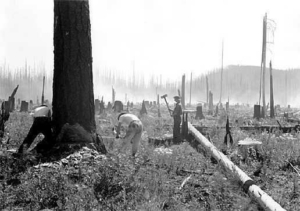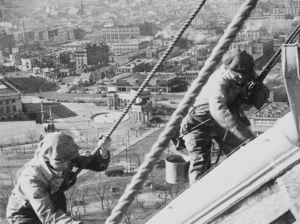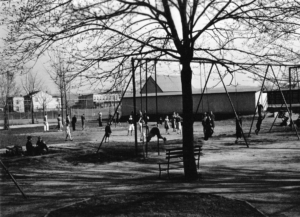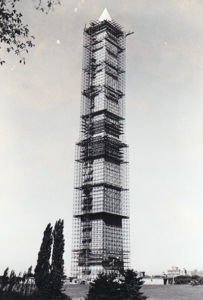
CCC forestry
Men of the Civilian Conservation Corps cleared brush, fought fires and replanted forests. Courtesy, US Forest Service.
Maintenance is much on my mind as megafires once again rage across California and President Biden’s infrastructure proposals collide with the partisan stonewall in Congress. During the 1930s, it took about 16,000 Civilian Conservation Corps (CCC) recruits two years to build the Ponderosa Way, an 800-mile-long fire break the length of the Sierra Nevada. A few decades of neglect following the Second World War erased the fire break from the landscape and memory. Now, it will take trillions of dollars of public investment to redress the nation’s decaying infrastructure which, like the Ponderosa, Americans largely but unknowingly owe to the New Deal.

Repairing the gold dome, 1934.
Civil Works Administration workmen cleaning and painting the dome at the Colorado State Capitol. Courtesy, Wikimedia Commons.
Infrastructure undergirds the growth of all complex civilizations. Its neglect or sabotage contributes mightily to their fall. In 1936, the top marginal tax rates in the U.S. jumped from 63 to 79 percent, largely to pay for the New Deal’s public works programs. It rose further still to 92 percent in 1952 under President Eisenhower. But that rate began to fall sharply in the 1980s during the Reagan Administration. Though already low, funding for infrastructure plummeted after 2010, falling far short of the $450 billion annually that the American Society of Civil Engineers 2021 Report Card for America’s Infrastructure says would be needed to protect public safety and assure productivity.

Rosedale Playground, Washington, D.C.
The WPA renovated city playgrounds. WPA and National Youth Administration (NYA) workers ran recreation programs. Courtesy, National Archives.
Maintenance is not sexy, nor do politicians reap credit for it, so it’s easy to scrimp. The millions of public jobs created by New Deal agencies during the Great Depression made the 1930s a golden age not just of building but also of maintenance. Refurbishing schools and parks raised the spirits of those who used them and arguably contributed to the social order. In fact, 80 percent of Americans today support rebuilding our nation’s infrastructure—more than almost any other top issue facing the current Administration. According to the Value of Water’s 2020 National Survey on Public Opinion on Water Infrastructure, nearly everyone (97 percent) said that America’s infrastructure is at least somewhat important. Only strengthening the economy ranked slightly higher, at 81 percent, and the two are inextricably linked.
In 1942, as Washington closed down work relief agencies such as the Works Progress Administration and CCC to free men up for war, Roberts Mann, the Superintendent of Maintenance for the Forest Preserve District of Cook County, Illinois, wrote in Parks and Recreation what he saw coming to Chicago’s richly endowed parks and those elsewhere as they “entered upon the lean years:”
“The past ten have been years of plenty—too fat for those of us who blithely drifted with the flood of federal labor and materials, to find ourselves with more acres, more buildings, more facilities and more frosting-on-the-cake than we possibly can maintain. It has been proven that poor maintenance engenders disrespect, misuse, abuse and vandalism by the public. Dirt breeds dirt, disorder breeds more disorder; shoddy, ill-kempt buildings and grounds invite contemptuous, careless treatment by our customers.
Mann could well have been describing our own time, though it was not war but a starved tax base—even in fat years—that led the nation to neglect the maintenance that has held it—and its people—together.
